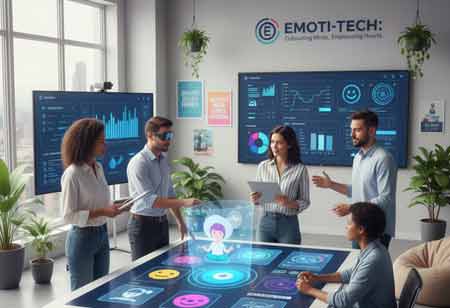THANK YOU FOR SUBSCRIBING
Be first to read the latest tech news, Industry Leader's Insights, and CIO interviews of medium and large enterprises exclusively from Education Technology Insights
The Whole Learner Strategy: SEL as the Heart of Platform Differentiation
SEL is crucial in edtech, as it enhances user engagement and retention while fostering holistic student development beyond just content delivery.

By
Education Technology Insights | Friday, October 10, 2025
Stay ahead of the industry with exclusive feature stories on the top companies, expert insights and the latest news delivered straight to your inbox. Subscribe today.
In a digital landscape saturated with educational technology platforms, the race for market leadership is no longer won solely on the breadth of content or the sophistication of algorithms. A new, more human-centric battleground has emerged, and the key to victory lies not just in educating the mind but in nurturing it. Social-Emotional Learning (SEL) has transitioned from a pedagogical ideal to a core business imperative. Visionary edtech platforms are now strategically embedding emotional skill-building into their core architecture, recognizing it as the ultimate differentiator to drive deeper user engagement and secure long-term retention.
The Evolution from Content Repositories to Learning Ecosystems
The first wave of edtech was revolutionary in its mission to democratize access to information. Platforms were essentially digital libraries and testing centers, focusing on the ‘what’ of learning—the curriculum, the facts, and the figures. Success was measured by the volume of content and the accuracy of the knowledge assessment. While foundational, this model often overlooks a critical variable in the educational equation: the learner's internal state.
Today, the industry is undergoing a profound paradigm shift, moving from the ‘what’ to the ‘how’ of learning. The modern educational philosophy recognizes that a student is not a passive receptacle for information but an active participant whose emotional and social well-being is intrinsically linked to their cognitive abilities. This understanding of holistic development has paved the way for SEL to become a strategic pillar. Platforms are evolving from static content repositories into learning ecosystems that adapt not just to a user’s knowledge gaps, but also to their emotional needs. This focus on the process of learning, rather than just its outputs, is where a lasting competitive advantage is being built.
The Neuroscience of Engagement
At its core, learning is a biological process, and emotions are the gatekeepers of cognition. Neuroscience provides compelling evidence for why integrating SEL is not a "soft" initiative but a hard-coded strategy for effectiveness. When a learner feels anxious, frustrated, or disconnected, their brain enters a state of threat or vigilance. The amygdala, the brain's emotional processing center, becomes overactive, effectively hijacking the prefrontal cortex, which is responsible for higher-order thinking, problem-solving, and memory consolidation. As a result, cognitive load increases, and the capacity to absorb and retain new information plummets.
By actively incorporating SEL, edtech platforms can help modulate these emotional responses. Skills like mindfulness, self-regulation, and stress management, when taught and reinforced through the platform, help learners maintain a state of calm, focused attention. When a student feels safe, confident, and emotionally balanced, their brain is primed for learning. Information flows more freely, connections are made more easily, and the learning experience becomes more effective and enjoyable. Platforms that cultivate this positive emotional state are not just teaching subjects; they are creating the optimal neurochemical conditions for learning to occur, leading to naturally higher engagement.
SEL as a Powerful Engine for Retention
While engagement captures a user’s attention in the moment, retention earns their long-term loyalty—and SEL is emerging as a powerful driver of that loyalty. By nurturing emotional connection and resilience, SEL creates a self-sustaining “flywheel” effect that keeps users returning. One of the key challenges in user retention is the feeling of frustration or failure that leads to disengagement. Traditional platforms that focus solely on right-or-wrong outcomes often reinforce a fixed mindset. In contrast, SEL cultivates a growth mindset by teaching perseverance, goal-setting, and resilience. When learners feel supported after mistakes and recognized for effort rather than innate ability, they develop a positive learning identity—seeing the platform not as a judge, but as a partner in their personal growth.
Humans are inherently social, and the most engaging digital experiences often stem from connection and community. As edtech increasingly adopts collaborative and project-based learning, SEL becomes essential to equip learners with empathy, communication, and decision-making skills. By fostering these abilities, platforms transform group interactions from sources of friction into opportunities for genuine collaboration and a sense of belonging. When learners feel psychologically safe and part of a meaningful community, their emotional investment deepens—the platform becomes not just a tool, but a shared space they want to remain part of.
The next evolution in personalization lies beyond adaptive academic content—it’s emotional personalization. SEL-integrated platforms can recognize frustration through behavior patterns, response times, or self-reported moods, and respond empathetically with encouragement, mindfulness breaks, or confidence-building activities. This responsiveness humanizes the digital experience, making users feel understood and cared for. As the edtech industry faces a sea of sameness driven by content and algorithms, the platforms that will endure are those built on emotional intelligence and a deep understanding of human psychology.
Investing in SEL is no longer a philanthropic sidebar; it is the most logical and potent business strategy for the coming decade. It directly addresses the core drivers of user behavior by making learning more effective, enjoyable, and psychologically rewarding. By weaving SEL into the very fabric of their products, edtech companies are not just adding a feature—they are building an unassailable competitive moat. They are creating platforms that users not only need, but also love, trust, and choose to grow with. In the quest to educate the next generation, the most successful enterprises will be those that remember to nurture the whole person.







